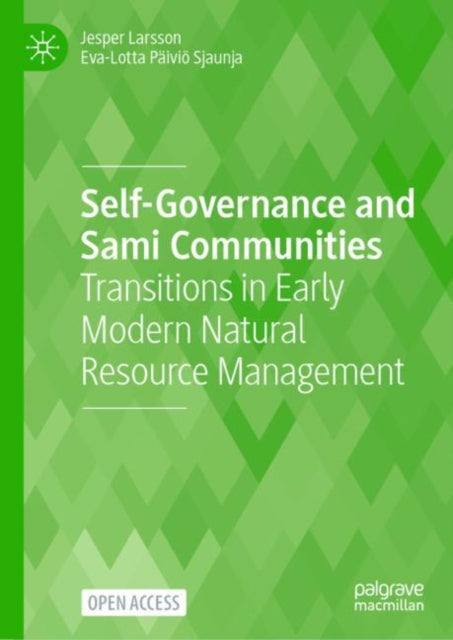Jesper Larsson,Eva-Lotta Pa ivio Sjaunja
Self-Governance and Sami Communities: Transitions in Early Modern Natural Resource Management
Self-Governance and Sami Communities: Transitions in Early Modern Natural Resource Management
YOU SAVE £5.85
- Condition: Brand new
- UK Delivery times: Usually arrives within 2 - 3 working days
- UK Shipping: Fee starts at £2.39. Subject to product weight & dimension
Bulk ordering. Want 15 or more copies? Get a personalised quote and bigger discounts. Learn more about bulk orders.
Couldn't load pickup availability
- More about Self-Governance and Sami Communities: Transitions in Early Modern Natural Resource Management
This book explores how early modern indigenous Sami inhabitants in interior northwest Fennoscandia built institutions for governance of natural resources, focusing on how they made decisions regarding natural resource management and how they altered the long-term rules for use of land and water in a self-governance context.
\n Format: Paperback / softback
\n Length: 247 pages
\n Publication date: 29 November 2021
\n Publisher: Springer Nature Switzerland AG
\n
This open-access book employs an interdisciplinary approach that delves not only into social organization but also examines the intricate interplay between societies and ecological contexts. How did the early modern indigenous Sami inhabitants in interior northwest Fennoscandia establish institutions for the governance of natural resources? The book seeks to answer this question by exploring how they made decisions regarding natural resource management, particularly with regard to wild game, fish, and grazing land. It sheds light on how Sami users, in a shifting economy, altered the long-term rules for the use of land and water within a self-governance context.
The early modern period witnessed a significant transformation of property rights, driven by fundamental shifts in the Sami economy. From a livelihood centered around fishing and hunting to one dominated by reindeer pastoralism, many Sami shifted their focus and resources towards this new occupation.
This book offers a fresh perspective on the remarkable organization and governance abilities of indigenous inhabitants in managing natural assets. It highlights their proficiency in establishing highly functional institutions that effectively oversaw and protected these valuable resources. Through a comprehensive analysis, the book sheds light on the intricate web of social, economic, and ecological factors that shaped the management practices of the Sami during this transformative era.
The interdisciplinary approach adopted in this book allows for a holistic understanding of the complex dynamics between societies and ecological settings. It explores the interdependencies and interactions between different groups, such as the Sami, local communities, and the broader natural environment. By examining these relationships, the book provides insights into the strategies and adaptations employed by the Sami to navigate and thrive in their diverse landscapes.
The book's exploration of natural resource management is particularly insightful. It sheds light on the decision-making processes and strategies employed by the Sami to allocate and regulate access to resources such as wild game, fish, and grazing land. It reveals the intricate social and economic dynamics that shaped these practices, including the role of traditional knowledge, customs, and institutions in maintaining resource sustainability.
Furthermore, the book delves into the ways in which Sami users altered the long-term rules for the use of land and water within a self-governance context. It examines the processes by which they negotiated and established new agreements, rules, and regulations to ensure the sustainable management of natural resources. The book highlights the importance of community participation, collaboration, and dialogue in the governance of natural resources, emphasizing the role.
In conclusion, this open-access book offers a valuable contribution to the study of social organization, ecological settings, and indigenous governance. It employs an interdisciplinary approach that provides a comprehensive understanding of the complex dynamics between societies and ecological contexts. Through its exploration of natural resource management, the book sheds light on the remarkable organization and governance abilities of the early modern indigenous Sami inhabitants in interior northwest Fennoscandia. It highlights their proficiency in establishing highly functional institutions that effectively oversaw and protected these valuable resources. By examining the interdependencies and interactions between different groups, the book offers insights into the strategies and adaptations employed by the Sami to navigate and thrive in their diverse landscapes. The book's findings have implications for understanding indigenous governance, sustainable resource management, and the preservation of cultural heritage in the face of changing economic and environmental conditions.
\n Weight: 352g\n
Dimension: 147 x 208 x 24 (mm)\n
ISBN-13: 9783030875008\n
Edition number: 1st ed. 2022\n
This item can be found in:
UK and International shipping information
UK and International shipping information
UK Delivery and returns information:
- Delivery within 2 - 3 days when ordering in the UK.
- Shipping fee for UK customers from £2.39. Fully tracked shipping service available.
- Returns policy: Return within 30 days of receipt for full refund.
International deliveries:
Shulph Ink now ships to Australia, Belgium, Canada, France, Germany, Ireland, Italy, India, Luxembourg Saudi Arabia, Singapore, Spain, Netherlands, New Zealand, United Arab Emirates, United States of America.
- Delivery times: within 5 - 10 days for international orders.
- Shipping fee: charges vary for overseas orders. Only tracked services are available for most international orders. Some countries have untracked shipping options.
- Customs charges: If ordering to addresses outside the United Kingdom, you may or may not incur additional customs and duties fees during local delivery.


